Ornithoteuthis volatilis
Richard E. Young and Michael VecchioneIntroduction
Ornithoteuthis volatilis is known from the Pacific and Indian Oceans. It appears to be a larger species than its Atlantic congener, O. antillarum, reaching at least 269 mmML.
Characteristics
- Arms (Sasaki, 1929)
- Arm IV with 75 suckers, others each with 50 or more (male, 213 mm ML).
- Suckers of arms II and III much larger than those of arms I and IV.
- Proximal suckers with several close-set teeth, central 1-3 much more slender and sharply pointed. Largest suckers (eg, ca. suckers 13-16) with 10-14 teeth, all sharply pointed, closely set, long and short alternately and with 2 or 3 most ventral on either side much the broadest and obliquely pointed. Distal suckers (ca. sucker 20 or more) with less than 7 teeth, separated, slenderly triangular, sharply pointed except ventral-most on either side with very broad and less quandrangular shape.
- No sexual dimorphism [in size?].
- Right arm IV hectocotylized (Sasaki, 1929).
- Proximal two thirds of arm: 14 large, basal suckers followed by 20 of reduced size of which the ventral series is far smaller; suckers 2-4 of latter series not true suckers but papilliform.
- Distal one third of arm: 25 sucker pairs represented by "peduncular bases swollen into transverse, membranes papillae." Papillae closely set in two series, comb-like; ventral series much smaller with rudimentary suckers on tips of papillae. Two series separated by membranous ridge along median line.
- Dorsal protective membrane absent from arm tip; ventral protective membrane normal in proximal third of arm then becomes broad and very thick.
- Honeycomb region with 14 pits and numerous grooves and ridges. Pits in longitudinal series, each with two transverse grooves extending towards membrane margin. Ridges lie opposite grooves and anastomose with one another, bordering numerous small, roundish or ovalish depressions.
 Click on an image to view larger version & data in a new window
Click on an image to view larger version & data in a new window
Fugure. Oral view of sucker rings from arm III of O. volatilis, male, 213 mm ML, Japanese waters. Numbers are approximate sucker number from arm base. Drawings from Sasaki (1929).
- Arm IV with 75 suckers, others each with 50 or more (male, 213 mm ML).
- Tentacles (Sasaki, 1929)
- Length of sucker-bearing club about half of tentacle length.
- About 12 suckers in carpal region of club; sucker rings each with 8-12 conical teeth distally with broader, triangular, oblique and more closely set more proximally.
- Manus with quadraserial suckers with 7-9 suckers in each series; central two series much larger; largest about 3 times marginal suckers in size; large manus suckers wide and deep, other club suckers shallower than broad. Inner ring of large manus suckers with margin entirely toothed, consisting of sharply pointed, slightly curved teeth (= ordinary teeth) alternating with small, plate-like, semi-lunar teeth (= accessory teeth); latter teeth nearly absent in largest suckers.
- Marginal and dactylus sucker rings with ordinary and accessory teeth ordinary teeth on proximal margin broad, oblique, triangular and closely set, those of distal margin slender, conical and separated.
- Dactylus suckers quadraserial in 27 transverse rows; dorsal suckers smaller than those more ventral.
- Carpal locking apparatus with 1 or 2 low knobs, no smooth-ringed suckers; apparatus indistinct in some specimens (Wormuth, 1976).
 Click on an image to view larger version & data in a new window
Click on an image to view larger version & data in a new window
Figure. Oral and oblique views of various club suckers of O. volatilis. Drawings from Sasaki (1929).
- Length of sucker-bearing club about half of tentacle length.
- Head
- Beaks: Descriptions can be found here: Lower beak; upper beak.
- Beaks: Descriptions can be found here: Lower beak; upper beak.
- Funnel (Sasaki, 1929)
- Foveola without longitudinal folds; side pockets absent.
- Foveola without longitudinal folds; side pockets absent.
- Photophores
- Photophores apparently as in O. antillarum.
Comments.
See the Ornithoteuthis page for comparisons of the two species.
Life History
Toshi Wakabayashi and Richard E. Young
Our most detailed knowledge of the paralarvae of O. volatilis is from a collection made predominately near the Ogasawara Islands, south of Japan, near 31°N 134°E (Wakabayashi, et al., 2002).
- Proboscis
- Proboscis long; PI (Proboscis Index - ratio between proboscis length and mantle length) = 0.24 - 0.66 (mean = 0.43).
- Lateral proboscis suckers 1.7 - 2.6 times (mean = 2.1) diameter of medial suckers.
- Proboscis split to form two tentacles at slightly more than 5.4 mm ML (largest paralarva examined which was almost fully split).
- Photophores
- Anterior intestinal photophore present by 3.0-3.5 mm ML; smaller posterior intestinal photophore not observed (Wormuth, et al., 1992 found both photophores present by 3.5 mm ML).
- Small round photophore on ventral surface of each eye by 3.0 mm ML (often indistinct however).
 Click on an image to view larger version & data in a new window
Click on an image to view larger version & data in a new window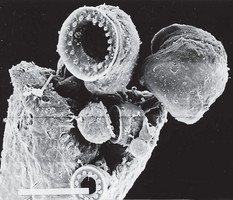
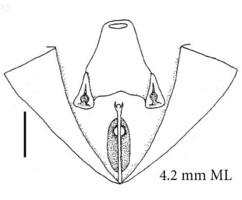
Figure. Paralarvae of O. volatilis. Left - Scanning electron micrograph of suckers at the tip of the proboscis, 3.6 mm ML. Scale bar = 100 µm. Right - Ventral view of the mantle cavity showing the anterior intestinal photophore. Scale bar = 1.0 mm. Photograph and drawing from Wakabayashi et al. (2002).
- At 2.5 mm ML:
- Dorsal mantle - 4 chromatophores (C) in diamond pattern; single C at posterior end.
- Ventral mantle - 6 C in a circle; 0 C along anteroventral margin; 1 pair at posterior end.
- Head - 6 C on dorsal surface; 2 C on ventral surface near eyes, 1 pair on posteroventral margin.
- Funnel - 2 C at anterior end.
- Buccal region - 2 C on outer lip between arms II and III.
- At 4.0 mm ML:
- Dorsal mantle - Same except 5 C in diamond pattern.
- Ventral mantle - 8 C in a circle; 5 C along anteroventral margin; 2 pairs at posterior end.
- Head - 8 C on dorsal surface, 4 on ventral surface.
- Funnel - Same.
- Buccal region - Same.
- At 5.1 mm ML:
- Dorsal mantle - Same
- Ventral mantle - Same except 7 C at posterior "end;" 2 C on anteroventral region.
- Head - 10 C on dorsal surface; 6 on ventral surface.
- Funnel - Same.
- Buccal region - Same.
Off eastern Australia the size and distribution of paralarvae suggest that spawning occurs in waters of tropical orgin and together with the sizes of adults suggests extened, perhaps year-round spawning in this region (Dunning, 1988).
Females generally reach maturity at 150 mm ML and males at 130 mm ML in Australian waters but considerable variation is found; for example a female of 269 mm ML was not fully mature and a male of 199 mm ML was maturing (Dunning, 1998).
Distribution
Type locality: Off Atami , Sagami Province, Honshu, Japan.
General distribution - Tropical to subtropical IndoPacific waters and tropical waters off west Africa: In the western edge of the Pacific O. volatilis is known from 36°N to 38°S and it extends eastward to the Line Islands at 140°W. In the Indian Ocean it is found from the Arabian Sea to Madagascar and in the Timor Sea. In the Atlantic it is known off Namibia (Villanueva, 1992). Captured generally over slope waters by midwater or demersal trawls. Off Australia it was taken only in demersal trawls where the bottom depth ranged from 400 m to 732 m. (Dunning, 1998)
References
Dunning, M. C. 1998. A Review of the systematics, distribution, and biology of the arrow squid genera Ommastrephes Orbigny, 1835, Sthenoteuthis Verrill, 1880, and Ornithoteuthis Okada, 1927 (Cephalopoda: Ommastrephidae). Smiths. Contr. Zool., No. 586: 425-433.
Roeleveld, M. A. 1988. Generic interrelationships within the Ommastrephidae (Cephalopoda). P.277-314. In: M. R. Clarke and E. R. Trueman (eds.). The Mollusca. Vol. 12. Paleontology and Neontology of Cephalopods. Academic Press, N.Y., 355pp.
Sasaki, M. 1929. A Monograph of the Dibranchiate Cephalopods of the Japanese and Adjacent Waters. Journal of the College of Agriculture, Hokkaido Imperial University, 20(supplement):357 pages.
Villanueva, R. 1992. Cephalopods of Namibia: Three life strategies in the Benguela System. Ph.D. Thesis, Universitat de Barcelona, 194 pp.
Wakabayashi, T., K. Saito, K. Tsuchiya and S. Segawa. 2002. Descriptions of Eucleoteuthis luminosa (Sasaki, 1915) and Ornithoteuthis volatilis (Sasaki, 1915) paralarvae in the Northwestern Pacific. Venus, 60 (4): 237-260.
About This Page

University of Hawaii, Honolulu, HI, USA

National Museum of Natural History, Washington, D. C. , USA
Page copyright © 2014 and
 Page: Tree of Life
Ornithoteuthis volatilis .
Authored by
Richard E. Young and Michael Vecchione.
The TEXT of this page is licensed under the
Creative Commons Attribution-NonCommercial License - Version 3.0. Note that images and other media
featured on this page are each governed by their own license, and they may or may not be available
for reuse. Click on an image or a media link to access the media data window, which provides the
relevant licensing information. For the general terms and conditions of ToL material reuse and
redistribution, please see the Tree of Life Copyright
Policies.
Page: Tree of Life
Ornithoteuthis volatilis .
Authored by
Richard E. Young and Michael Vecchione.
The TEXT of this page is licensed under the
Creative Commons Attribution-NonCommercial License - Version 3.0. Note that images and other media
featured on this page are each governed by their own license, and they may or may not be available
for reuse. Click on an image or a media link to access the media data window, which provides the
relevant licensing information. For the general terms and conditions of ToL material reuse and
redistribution, please see the Tree of Life Copyright
Policies.
- First online 29 November 2009
- Content changed 21 January 2014
Citing this page:
Young, Richard E. and Michael Vecchione. 2014. Ornithoteuthis volatilis . Version 21 January 2014 (under construction). http://tolweb.org/Ornithoteuthis_volatilis/77434/2014.01.21 in The Tree of Life Web Project, http://tolweb.org/




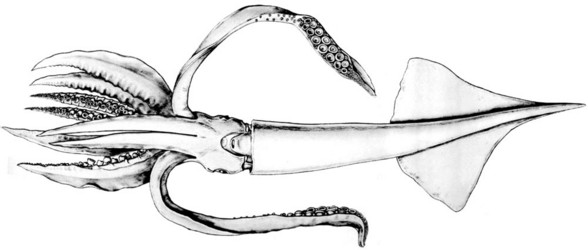

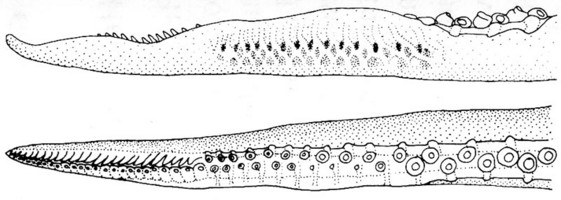
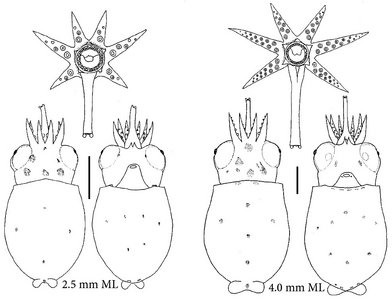
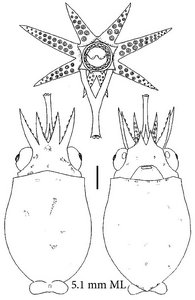
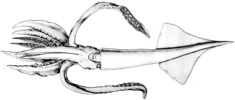


 Go to quick links
Go to quick search
Go to navigation for this section of the ToL site
Go to detailed links for the ToL site
Go to quick links
Go to quick search
Go to navigation for this section of the ToL site
Go to detailed links for the ToL site